Milhaud, Corcovado For Cello And Piano (Eschig)
Milhaud, Corcovado for Cello and Piano (Eschig)
Darius Milhaud was born in Aix-en-Provence, France, on September 4, 1892. Growing up in a family that valued music, Milhaud was exposed to various sounds and styles from an early age. His father, a merchant, was a keen amateur musician who played the violin, while his mother was an accomplished pianist. Milhaud began composing at a young age, experimenting with different sounds and styles.
Early Life and Education
Milhaud's musical training began in earnest when he entered the Paris Conservatory at 17. There, he studied under some of the leading composers of the time, including Charles-Marie Widor and Vincent d'Indy. During his time at the Conservatory, Milhaud first encountered the music of Claude Debussy, whose innovative approach to composition would profoundly impact his work.
After completing his studies, Milhaud returned to Aix-en-Provence, where he formed a close friendship with the writer and artist Jean Cocteau. The two collaborated on several projects, including the ballet "Le Boeuf sur le Toit," one of Milhaud's most famous works.
Musical Style and Influences
Milhaud's musical style was characterized by its eclecticism and versatility. He drew on a wide range of influences, including jazz, Brazilian music, and the traditional music of his native Provence. Complex rhythms, unusual harmonies, and unconventional instrumentation often marked his compositions.
One of Milhaud's most important influences was the composer Erik Satie, whose avant-garde approach to composition challenged traditional notions of musical form and structure. Milhaud was also influenced by the work of the Russian composer Igor Stravinsky, whose use of folk music and unconventional rhythms profoundly impacted his own work.
Milhaud's Most Famous Compositions
Milhaud's most famous composition, "Le Boeuf sur le Toit," was written in collaboration with Jean Cocteau. The ballet, first performed in 1920, is a lively and playful work that draws on various musical styles, including Brazilian samba and French cabaret music. The piece was an instant success and helped to establish Milhaud's reputation as one of the leading composers of his time.
Another of Milhaud's most famous works is the Suite for Piano and Orchestra, composed in 1919. The piece is notable for its use of complex rhythms and harmonies and its unconventional instrumentation, including saxophones and percussion.
Milhaud's Legacy and Impact on Music
Darius Milhaud's legacy is rich and varied, encompassing a vast repertoire of compositions that spanned many different styles and genres. His innovative approach to composition, which drew on a range of influences from around the world, helped to redefine the boundaries of classical music and paved the way for future generations of composers.
Milhaud's influence can be seen in the work of many composers who came after him, including the American composer Aaron Copland, greatly influenced by Milhaud's use of folk music and unconventional harmonies. Milhaud's legacy also lives on through the many recordings of his music that continue to be made and performed worldwide.
Conclusion
Darius Milhaud was a composer of great talent and originality whose innovative composition approach helped redefine the boundaries of classical music. His vast repertoire of compositions, which drew on various influences from around the world, continues to be celebrated and performed today.
From his early years in Aix-en-Provence to his later years as a professor of music at Mills College in California, Milhaud's life was dedicated to pursuing music and the arts. Through his collaborations with artists such as Jean Cocteau and his vast repertoire of compositions, we can discover Milhaud's unique creative vision and impact on the world of music.

Milhaud, Corcovado for Cello and Piano (Eschig)
Milhaud, Sorocaba for Cello and Piano (Eschig)
Milhaud, Sumare for Cello and Piano (Eschig)
Milhaud, Tijuca for Cello and Piano (Eschig)
Milhaud, Sonatine for Violin and Cello (Heugel)